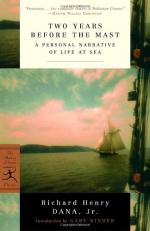This wind (the southeaster) is the bane of the coast of California. Between the months of November and April (including a part of each), which is the rainy season in this latitude, you are never safe from it; and accordingly, in the ports which are open to it, vessels are obliged, during these months, to lie at anchor at a distance of three miles from the shore, with slip-ropes on their cables, ready to slip and go to sea at a moment’s warning. The only ports which are safe from this wind are San Francisco and Monterey in the north, and San Diego in the south.
As it was January when we arrived, and the middle of the southeaster season, we came to anchor at the distance of three miles from the shore, in eleven fathoms water, and bent a slip-rope and buoys to our cables, cast off the yard-arm gaskets from the sails, and stopped them all with rope-yarns. After we had done this, the boat went ashore with the captain, and returned with orders to the mate to send a boat ashore for him at sundown. I did not go in the first boat, and was glad to find that there was another going before night; for after so long a voyage as ours had been, a few hours seem a long time to be in sight and out of reach of land. We spent the day on board in the usual duties; but as this was the first time we had been without the captain, we felt a little more freedom, and looked about us to see what sort of a country we had got into, and were to pass a year or two of our lives in.
It was a beautiful day, and so warm that we wore straw hats, duck trousers, and all the summer gear. As this was midwinter, it spoke well for the climate; and we afterwards found that the thermometer never fell to the freezing point throughout the winter, and that there was very little difference between the seasons, except that during a long period of rainy and southeasterly weather, thick clothes were not uncomfortable.
The large bay lay about us, nearly smooth, as there was hardly a breath of wind stirring, though the boat’s crew who went ashore told us that the long groundswell broke into a heavy surf on the beach. There was only one vessel in the port— a long, sharp brig of about three hundred tons, with raking masts, and very square yards, and English colors at her peak. We afterwards learned that she was built at Guayaquil, and named the Ayacucho, after the place where the battle was fought that gave Peru her independence, and was now owned by a Scotchman named Wilson, who commanded her, and was engaged in the trade between Callao and other parts of South America and California. She was a fast sailer, as we frequently afterwards saw, and had a crew of Sandwich-Islanders on board. Beside this vessel, there was no object to break the surface of the bay. Two points ran out as the horns of the crescent, one of which— the one to the westward— was low and sandy, and is that to which vessels are obliged to give a wide berth when running out for a southeaster; the




